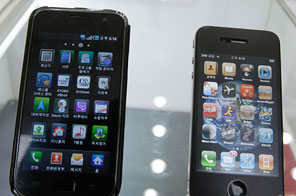Apple/Samsung: The Verdict on Innovation
A $1 billion U.S. jury verdict last week did more than determine that Samsung’s smartphones and tablets violated Apple’s patents—it also clouded the future of products and research based on Google’s open-source Android operating system.

Android, which is built into Samsung’s products, is used in more than 60 percent of the nearly 700 million smartphones expected to be sold worldwide this year, according to IDC, a leading technology research firm. In the months before the verdict, Google was already taking major steps to shore up its patent portfolio in order to protect Android, including by buying Motorola Mobility (see “Why Google Wants Motorola” and “Google’s Troubled Search for Valuable Patents”).
So the verdict (see “Apple Wins Big in Major Patent Trial”) has likely been a shock to many handset manufacturers, researchers, and product developers. Indeed, because Android is an open-source platform, it often serves as a major research test bed for next-generation wireless technology.
For example, anyone who wants to use now-familiar techniques like “pinching” and tapping a screen to zoom in on an image—which the jury decided violated Apple patents—will now have to think about whether this will trigger costly legal problems.
While the big smartphone players ultimately have incentives to settle matters and work together, that sort of concern dampens innovation, says Daron Acemoglu, an economist at MIT whose work includes a recent examination of the connection between the strength of patent protection and innovative output. “The implications for innovation are bad. This will block innovation because people cannot use promising ideas easily, and it will make everything much more bureaucratic, which is a huge problem already,” he says. “It’s a terrible verdict. It makes a mockery of patents. If anything good will come out of this, it is that we will take the idea of abolishing software patents more seriously.”
But others experts disagree, saying the decisions could enhance innovation by signaling that new ideas—especially ideas surrounding design and user interfaces—are worth investing in. “My own guess is this is probably a net add for innovation,” says R. Polk Wagner, a professor who specializes in intellectual property law at the University of Pennsylvania.
Features like pinch-to-zoom feel obvious precisely because of the commercial success of the iPhone, he points out. Its natural feeling “makes it seem crazy that you could patent something like that,” he says, but that overlooks the fact that before Apple patented it, nobody was doing it. In any event, some of these design problems can be overcome with alternative approaches, he predicts. “Pinch-to-zoom and momentum scrolling, those sorts of things—my view is they’re more ornamental rather than fundamental aspects of operating smartphones.”
Still, the verdict is giving pause to some researchers who work on the Android platform. Anything that threatens to distract Google’s Android team from improving the core of Android, and thus keep up with competing operating systems, stands to hurt such research, says Ivan Seskar, an associate director and researcher at Winlab at Rutgers University (see “Do Patents Slow Down Innovation?”).
“Most probably, this will slow down technology development quite a lot,” he says. “It will do two things—it will force Google and others who are heavily invested in Android to circumvent the stuff that looks like iPhone. They will have to make something that looks different—having nothing to do with technology, but with appearances. And people who were thinking about developing Android-based products will start looking at RIM [Research in Motion, makers of Blackberry] and Windows, not because they are necessarily better technology, but they don’t look like iPhone and chances are they won’t be sued.”
With additional reporting by Rachel Metz in San Francisco.
Keep Reading
Most Popular
Large language models can do jaw-dropping things. But nobody knows exactly why.
And that's a problem. Figuring it out is one of the biggest scientific puzzles of our time and a crucial step towards controlling more powerful future models.
The problem with plug-in hybrids? Their drivers.
Plug-in hybrids are often sold as a transition to EVs, but new data from Europe shows we’re still underestimating the emissions they produce.
Google DeepMind’s new generative model makes Super Mario–like games from scratch
Genie learns how to control games by watching hours and hours of video. It could help train next-gen robots too.
How scientists traced a mysterious covid case back to six toilets
When wastewater surveillance turns into a hunt for a single infected individual, the ethics get tricky.
Stay connected
Get the latest updates from
MIT Technology Review
Discover special offers, top stories, upcoming events, and more.